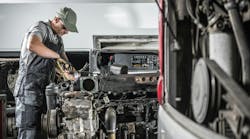Manager: David Baker
Title: Vice president of maintenance
Company: Boyd Bros. Transportation Inc., Clayton, AL
Operation: Nationwide flatbed carrier operating 2,500 trucks, including 1,050 conventional tractors and 1,670 48-ft. flatbed trailers
Problem:
For many fleets, batteries are almost always an afterthought in the daily crush of trucking’s operating needs—until something goes wrong and a jump-start is required. That’s when things get expensive and not just in terms of dollars and cents.
“The average cost of a jump-start is over $300,” explains David Baker, vice president of maintenance at nationwide flatbed hauler Boyd Bros. Transportation. “But that’s before you factor in the cost of vehicle downtime, much less the extra aggravation of the driver.”
To try and eliminate that issue, Baker says Boyd bought the best quality lead-acid batteries on the market. Yet, the batteries on its tractors wore out in about 18 to 22 months because of the harsh environments endured by Boyd’s trucks, especially in frigid winter weather.
And with its tractors on a 4- to 41/2-year trade cycle, Baker says that meant Boyd had to replace the vehicle’s entire battery set (comprised of four batteries per truck) three times per cycle.
Not only did the company spend a lot of money on extra batteries, it also required extra shop time to swap out the depleted batteries.
Solution:
In 2010, Boyd began preparing to switch from the diesel-fired auxiliary power units (APUs) it had been using since 2006 to ones powered by electricity. Baker says that at the time, the fleet knew it needed a different battery type, especially since its drivers would be relying on the APU for some 12 to 14 hours worth of power during their off-duty time.
“Switching to an electrically powered APU meant doubling the truck’s battery set, increasing it from four to eight batteries,” he explains. “We couldn’t keep doing what we were doing.”
For Boyd, absorbed glass mat (AGM) batteries offered the best solution. Though they cost 30% to 35% more than the previous lead-acid variety it used, Boyd found its AGM batteries now lasted a complete tractor trade cycle and reduced roadside jump-start incidents per winter season by over 90%, down into the single digits.
Specifically, Baker notes that the Trojan OverDrive AGM 31 battery it now specs to be factory-installed in its Navistar ProStar tractors required only four jump-starts per week over the course of this year’s winter months versus last season’s average of 21 jump-starts per week.
“With such a dramatic decrease in the number of dead batteries, our drivers avoided the unnecessary downtime of having to wait for a battery jump-start,” he says. Baker adds that the longer lifecycle of the AGM batteries also helped cut the fleet’s battery-related maintenance expenses by 50%.
“We first started out using AGM batteries as replacements for depleted lead-acid units,” he explains. “We wanted to show a return on investment via retrofits first before switching over to them wholesale and in greater numbers for our battery-powered APUs.”
Based on Boyd’s calculations, the AGM batteries paid for themselves in about a year because of their added longevity, durability, and reduced maintenance expenses.
Trojan notes that its deep-cycle OverDrive AGM 31 battery delivers 730 cold cranking amps even in extreme weather conditions. It is protected by its heavy-duty plate construction; corrosion-resistant grid design; use of high-density, low-porosity paste; and tough polypropylene exterior casing.
“The biggest benefit, though, is for our drivers,” Baker says. “They need to get about 12 to 14 hours of power out of them for their APUs when parked off-duty, yet still be able to turn the truck over when they get back on the road. Keeping our drivers comfortable while sparing them the aggravation of a jump-start is what’s really important here.”



